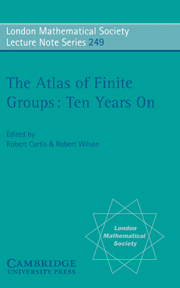Book contents
- Frontmatter
- Contents
- Introduction
- Addresses of registered participants
- Addresses of non-participating authors
- Programme of lectures
- Conference photograph and key
- Symmetric presentations and orthogonal groups
- A constructive recognition algorithm for the special linear group
- Relations in M666
- A survey of symmetric generation of sporadic simple groups
- Harish-Chandra theory, q-Schur algebras, and decomposition matrices for finite classical groups
- The Meataxe as a tool in computational group theory
- Branching rules for modular projective representations of the symmetric groups
- Characters and surfaces: a survey
- On the characterization of finite groups by characters
- Finite linear groups of small degree
- Minimal parabolic systems for the symmetric and alternating groups
- Probabilistic methods in the generation of finite simple groups
- Condensing tensor product modules
- Intersections of Sylow subgroups in finite groups
- Anatomy of the Monster: I
- An integral ‘Meat-axe’
- Finite rational matrix groups: a survey
- Chamber graphs of sporadic group geometries
- An Atlas of sporadic group representations
- Presentations of reductive Fischer groups
- A brief history of the ATLAS
Harish-Chandra theory, q-Schur algebras, and decomposition matrices for finite classical groups
Published online by Cambridge University Press: 19 May 2010
- Frontmatter
- Contents
- Introduction
- Addresses of registered participants
- Addresses of non-participating authors
- Programme of lectures
- Conference photograph and key
- Symmetric presentations and orthogonal groups
- A constructive recognition algorithm for the special linear group
- Relations in M666
- A survey of symmetric generation of sporadic simple groups
- Harish-Chandra theory, q-Schur algebras, and decomposition matrices for finite classical groups
- The Meataxe as a tool in computational group theory
- Branching rules for modular projective representations of the symmetric groups
- Characters and surfaces: a survey
- On the characterization of finite groups by characters
- Finite linear groups of small degree
- Minimal parabolic systems for the symmetric and alternating groups
- Probabilistic methods in the generation of finite simple groups
- Condensing tensor product modules
- Intersections of Sylow subgroups in finite groups
- Anatomy of the Monster: I
- An integral ‘Meat-axe’
- Finite rational matrix groups: a survey
- Chamber graphs of sporadic group geometries
- An Atlas of sporadic group representations
- Presentations of reductive Fischer groups
- A brief history of the ATLAS
Summary
Abstract
We give a survey on the present state of knowledge in the representation theory of finite groups of Lie type in the non-defining characteristic case. A systematic use of Harish-Chandra induction leads to the definition of q-Schur algebras. Their representation theory yields explicit information on the decomposition matrices for classical groups.
Introduction
This paper is an extended version of my talk given at the conference. It is intended as a brief survey on recent developments in the representation theory of finite groups of Lie type in non-defining characteristic.
Let G = G(q) denote a finite group of Lie type. Examples are classical groups such as GLn(q) or Spn(q), but also exceptional groups such as E8(q). Let κ be an algebraically closed field of characteristic l ≥ 0 and assume that l does not divide q. We are interested in the category κG-mod of finitely generated left κG-modules.
If l = 0 (or, more generally, l ⊥ |G|, the order of G), every finite dimensional κG-module is completely reducible. Hence it suffices to find the simple κG-modules. In 1955, Green determined the ordinary character table for the general linear groups GLn(q) [26], thus solving the problem for these groups. Beginning with the seminal paper [7] of Deligne and Lusztig in 1976, Lusztig arrived at a complete classification of the simple κG-modules for all finite groups of Lie type G (see Lusztig [36]).
The representation theory for these groups in characteristics l ≠ 0, l ⊥ q, started in 1982 with the fundamental paper [16] by Fong and Srinivasan, in which these authors determined the l-blocks of the general linear groups and the unitary groups.
- Type
- Chapter
- Information
- The Atlas of Finite Groups - Ten Years On , pp. 58 - 73Publisher: Cambridge University PressPrint publication year: 1998

